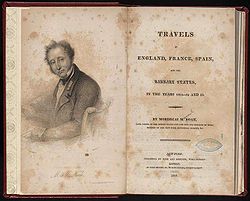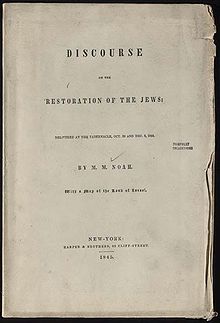- Mordecai Manuel Noah
-
Mordecai Manuel Noah (July 14, 1785, Philadelphia, Pennsylvania – May 22, 1851, New York) was an American playwright, diplomat, journalist, and utopian. Born in a family of Portuguese Sephardic ancestry;[1] he was the most important Jewish lay leader in New York in the pre-Civil War period,[2] and the first Jew born in the United States to reach national prominence.[3]
Contents
Career
Noah engaged in trade and law, but when removing to Charleston, South Carolina, dedicated himself to politics.
Diplomat
In 1811, he was appointed by President James Madison as consul at Riga, then part of Imperial Russia, but declined, and, in 1813, was nominated Consul to the Kingdom of Tunis, where he rescued American citizens kept as slaves by Moroccan masters. In 1815, Noah received a stunning blow;[4] In the words of US Secretary of State James Monroe, his religion was "an obstacle to the exercise of [his] Consular function." The incident caused outrage among Jews and non-Jews alike.[5]
Noah sent many letters to the White House trying to get an answer as to why they felt his religion should be a justifiable reason for taking the office of consul away. He had done well as consul and had even been able to accommodate the United States request to secure the release of some hostages being held in Algiers. Noah never received a legitimate answer as to why they took the office of Consul away from him. This worried Noah since he was afraid that this would set a precedent for the United States. He worried that this would block future Jews from holding publicly elected or officially granted offices within the United States.
Noah protested and gained letters from John Adams, Thomas Jefferson, and James Madison supporting church-state separation and tolerance for Jews.[6] Prominent Reform Judaism leader Isaac Harby was moved to write, in a letter to Monroe, "[Jews] are by no means to be considered as a religious sect, tolerated by the government. They constitute a portion of the People. They are, in every respect, woven in and compacted with the citizens of the Republic."[7]
Later career
Noah moved to New York, where he founded and edited The National Advertiser, The New York Enquirer (later merged into the New York Courier and Enquirer), The Evening Star, and The Sunday Times newspapers.
In 1819, Noah's most successful play, She Would Be a Soldier, was produced. That play has since established Noah as America's first important Jewish American writer. She Would Be a Soldier is now included in college level anthologies.
In 1825, with virtually no support from anyone-not even his fellow Jews- in a precursor to modern Zionism, he tried to found a Jewish "refuge" at Grand Island in the Niagara River, to be called "Ararat," after Mount Ararat, the Biblical resting place of Noah's Ark. He had brought with him a cornerstone which read "Ararat, a City of Refuge for the Jews, founded by Mordecai M. Noah in the Month of Tishri, 5586 (September, 1825) and in the Fiftieth Year of American Independence." Noah also shared the belief among various others that some of the Native American Indians were from the Lost Tribes of Israel, from which he wrote the Discourse on the Evidences of the American Indians being the Descendants of the Lost Tribes of Israel.[8] [9] In his Discourse on the Restoration of the Jews[10] Noah proclaimed his faith that the Jews would return and rebuild their ancient homeland and called on America to take the lead in this endeavor. On September 2, soon after arriving in Buffalo from New York, thousands of Christians and a smattering of Jews assembled for a historic event. Noah led a large procession,headed by Masons, a New York militia company, and municipal leaders paraded to St. Paul's Episcopal church.[11] Here, there was a brief ceremony- including a singing of the psalms in Hebrew- the cornerstone was laid on the communion table, and the new proclamation establishing the refuge was read. "Proclamation – day ended with music, cannonade and libation. 24 guns, recessional,masons retired to the Eagle Tavern, all with no one ever having set foot on Grand Isle." [12] This was the beginning and the end of Mordecai Noah's venture: he lost heart and returned to New York a couple days later without once having set foot on the island. The cornerstone was taken out of the audience chamber of the church and laid against the back of the building.[13] It is now on permanent display at the Buffalo Historical Society in Buffalo, NY.
From 1827-1828, Noah led New York City's Tammany Hall political machine.
He was a staunch supporter of slavery. He worried that emancipation would threaten the whole country's safety.
MacArthur Award-winning cartoonist Ben Katchor fictionalized Noah's scheme for Grand Island in his The Jew of New York. Noah is also a minor character in Gore Vidal's 1973 novel Burr.
The modern edition of Noah's writings is The Selected Writings of Mordecai Noah edited by Michael Schuldiner and Daniel Kleinfeld, and published by Greenwood Press.
American Conservative rabbi Henry Noah is a direct descendant.[14]
- 1813 - 1814: Travels in England, France, Spain, and the Barbary States
- 1837 : Discourse of the Evidence of the American Indians being the descendants of the Lost Tribes of Israël
- 1844: Discourse on the Restoration of the Jews
References
- ^ "Jewish Virtual Library, Mordecai Manuel Noah". http://www.jewishvirtuallibrary.org/jsource/biography/MNoah.html. Retrieved 2008-01-10.
- ^ New York Jewish History, New York State Archives, Jewish History Resources
- ^ "Antisemitism, Mordecai Manuel/Cart Catalogue". January 2010. http://www.americanjewisharchives.org/.
- ^ Hasia R. Diner, The Jews of the United States, 1654 to 2000, p.59
- ^ Noah, Mordecai (1819). Travels in England, France, Spain, and the Barbary States, in the Years 1813-14 and 15. Kirk and Mercein. pp. 376. http://books.google.com/books?id=8voLAAAAYAAJ&printsec=frontcover&dq=Travels+in+England,+France,+Spain,+and+the+Barbary+States,+in+the+Years+1813-14+and+15&hl=en&ei=N4fgTevcHIbn0QHqzbWwBw&sa=X&oi=book_result&ct=result&resnum=1&ved=0CCoQ6AEwAA#v=onepage&q&f=false. Retrieved 2011-05-28.
- ^ Richard H. Popkin, "Thomas Jefferson's Letter to Mordecai Noah," American Book Collector 1987 8(6): 9-11
- ^ "A "portion of the People"", Nell Porter Brown, Harvard Magazine, January–February, 2003
- ^ Noah, Mordecai (1837). Discourse on the Evidences of the American Indians being the Descendants of the Lost Tribes of Israel. J. Van Norden. http://books.google.com/books?id=h1G-AAAACAAJ&dq=DISCOURSE+ON+THE+EVIDENCES+OF+THE+AMERICAN+INDIANS+BEING+THE+DESCENDANTS+OF+THE+LOST+TRIBES+OF+ISRAEL. Retrieved 2008-10-02.
- ^ Mordecai Manuel Noah. "DISCOURSE ON THE EVIDENCES OF THE AMERICAN INDIANS BEING THE DESCENDANTS OF THE LOST TRIBES OF ISRAEL". Oliver’s Bookshelf. http://olivercowdery.com/texts/noah1837.htm. Retrieved 2008-09-03.
- ^ Noah, Mordecai (1845). Discourse on the Restoration of the Jews. Harper & Brothers. http://books.google.com/books?id=7fUEKQAACAAJ&dq=Discourse+on+the+Restoration+of+the+Jews. Retrieved 2008-10-02.
- ^ http://www.jewishmag.com/142mag/mordecai_manuel_noah/mordecai_manuel_noah.htm
- ^ Major Noah, American-Jewish Pioneer, by Isaac Goldberg, Jewish Publication Society of America, 1936, pg. 196
- ^ http://books.google.com/books?id=pJMDR73E8FwC&printsec=toc&client=firefox-a#PPA315,M1
- ^ http://ha-historion.blogspot.com/2006_12_01_archive.html
- Selig Adler & Thomas E. Connolly. From Ararat to Suburbia: the History of the Jewish Community of Buffalo (Philadelphia: the Jewish Publication Society of America, 1960, Library of Congress Number 60-15834).
Further reading
- Mordecai Manuel Noah: Travels in England, France, Spain, and the Barbary States: In the Years 1813-14 and 15
- Major Noah: American-Jewish Pioneer, Isaac Goldberg, The Jewish Publication Society of Philadelphia, 1936.
- The Selected Writings of Mordecai Noah, Michael Schuldiner and Daniel J. Kleinfeld, Greenwood Press, 1999.
- IsraIsland. Nava Semel, 2005.
External links
 Media related to Mordecai Manuel Noah at Wikimedia CommonsCategories:
Media related to Mordecai Manuel Noah at Wikimedia CommonsCategories:- 1785 births
- 1851 deaths
- People from Philadelphia, Pennsylvania
- American people of Portuguese-Jewish descent
- 19th-century Sephardi Jews
- American dramatists and playwrights
- Writers from New York
- American Zionists
- Leaders of Tammany Hall
- 19th-century American newspaper founders
- Jewish American dramatists and playwrights
Wikimedia Foundation. 2010.


